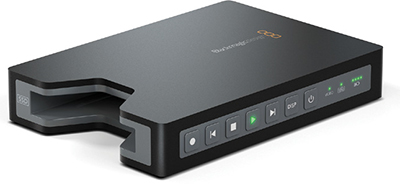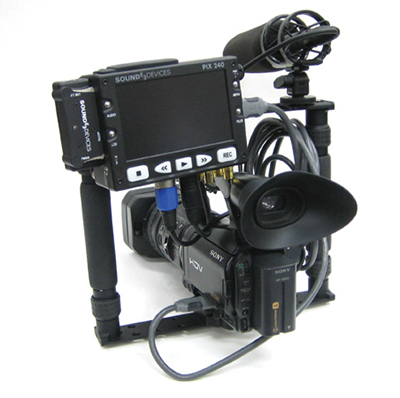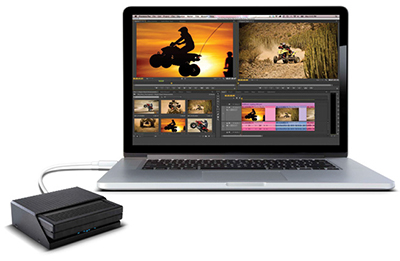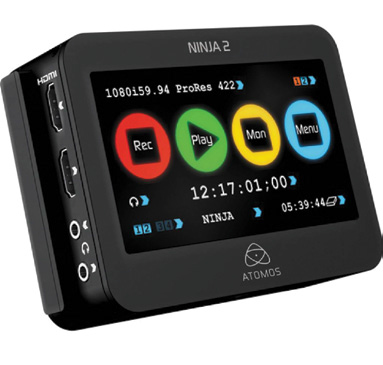Smaller and Smarter: Field Recording Hits New Heights
Blackmagic Design HyperDeck ShuttleSAN FRANCISCO—Go back a few years if you can, and it’s easy to recall that the process of getting much-prized video from the field and into the studio involved a fair amount of schlep and prep. And then there came the first inkling of something new: the ability to drop the bulky videocassette from the video camera altogether, and consider instead these new palm-sized recording devices that promised to do the heavy lifting of recording high-res video right there where you stood.

It’s true that the process of recording in the field has changed—so much so, that the question now is not whether it’s simple to record in the field, but rather how deep the features on a portable recording device can actually be. Tick off a list of what’s featured in the newest batch of portable storage and recording devices, and you get a listing of high-res LCD screens and on-the-fly NLE editing features, with the smallest of models packed with immensely powerful processors. There’s an enormous amount of technology available at a developer’s fingertips to make what previously was a simple step in video recording—record in the field, and then get it back to the studio—into a revamped, elegant and practical piece of the acquisition process that just happens to occur out in the muck and snow and wind of the real world.
SIZE MATTERS
One reality that’s very evident: size matters when it comes to successful solutions. For storage and recording options on the road, Blackmagic Design has offered new solutions as part of its HyperDeck Shuttle, one of the industry’s smallest solid-state 4:2:2 video recorders in a 2.5-inch, palmsized broadcast deck.
Files are captured in native uncompressed 10-bit QuickTime and compressed Apple ProRes 422 or Avid DNxHD MXF files. The next generation HyperDeck Shuttle 2 with ProRes compression serves to reduce the size of uncompressed HD video files while preserving fullframe 4:2:2 quality, allowing customers to record up to six times longer, the company said.
“Adding ProRes 422 recording and playback gives users the freedom to work in either compressed or uncompressed formats,” said Grant Petty, CEO of Blackmagic Design.

Sound Devices PIX 240 recorder The shuttle has standard deck-style function buttons with LEDs to indicate input signal lock, recording status and battery status, as well as closed-caption support.
At their most simple, today’s slate of portable recorders are designed to help videographers accelerate their workflow. That was certainly the case for Sound Devices. Simplifying the production and post checklist was a primary goal behind the development of the PIX 240i recorder, which records QuickTime files in either ProRes or DNxHD format, with files then ready for editing in an NLE.
Get the TV Tech Newsletter
The professional video industry's #1 source for news, trends and product and tech information. Sign up below.
What also sets the system apart, said Jon Tatooles, vice president of marketing and business development, is the device’s multi-angle offerings: it serves as recorder, frame rate scaler, converter, timecode generator and field monitor. The latest generation also has the ability to handle ProRes 4444 and can work with compact or solidstate flash drives. “The way we approach the market is to spend a lot of time with our customers in the field to see where trends are going,” Tatooles said. “What we offer are features customers are wanting to use now.” The company also offers the PIX 220i, designed for smaller format cameras.
Not only are there a growing number of manufacturers diving into the portable storage market, but more are recognizing the need for accessories to bring it all to fruition. AJA Video Systems recently introduced new storage and dock accessories for its Ki Pro family of tapeless video recording devices, including the KiStor Drive, which is a USB 3-enabled device, and the Thunderbolt-enabled KiStor Dock with USB3 connectivity.
Using SATA connectivity to connect to the recorders, the KiStore Drives are available with either one or two consumer connectivity ports. Likewise, the KiStor Dock is designed to mount KiStor drives on Mac or Windows desktops and then transfer files at high speed, the company said.
AJA Kistor Drive PORTABLE BACKUP
Calling it a removable archive that works alongside the company’s XT/XS series of server solutions, EVS offers its removable server, the XF2. The system has two removable hard disk drives for backup transfer during live or near-live production scenarios. It can serve as a backup platform for content in the XT3 and XS production servers and a gateway platform between EVS servers and NLE stations with Gigabit Ethernet connection.

The newest solution to hit the road is the XFly, a portable and compact storage platform that includes eight removable SATA hard drives with up to 6.2 TB of storage, providing up to 140 hours of HD at 100 Mbps.
These portable solutions are designed to offer operators an easy way to back up clips and feeds, the company said. When live shooting is complete, the operator is able to transport the entire production— including program feed, multicamera angles and highlights—in a single storage case. Features include on-the-fly MXF or QuickTime file wrapping and the ability to automatically generate proxy files while streaming multiple live fees simultaneously.

Atomos Ninja2 For recording in the field, Roland Systems Group has offered the F-1 video field recorder, which is able to capture HDV or DV directly to a hard drive in the field. The system offers two channels of balanced audio, a removable HDD, multiple power options and an RGB output for quick control and thumbnail viewing. The system offers HDV/DV and MPEG-2 50 Mbps recording. Users can record up to 27 hours of HD video on a 120 GB hard drive.
In addition to a long line of professional desktop storage solutions, Sonnet Technologies’ mobile solutions include four members of the Fusion family. The Fusion F2 portable SATA RAID storage system offers 1.5 TB of storage and the portable two-drive Fusion F2QR contains two 2.5- inch 1 TB drives. The company rounds out its mobile options with the Fusion Mobile Rack, an internal one-bay removable storage solution for PCs; and the Fusion F3, a portable two-drive RAID storage system with 6 TB of storage.
One of the first companies to introduce a portable digital video recorder with fullcolor video monitor was Fast Forward Video, which has found success with its SideKick HD recorder, a camera- or battery-mountable device that captures HD video up to 220 Mbps with 4:2:2 sampling and a number of codec options, including ProRes 422. In addition to a 4-inch color screen with playback options, the recorder can handle HD/SDI and HDMI with the ability to record on a SATA hard disk or solid state drive up to 1 TB.
Portable options also come in the form of the HD3, a portable, HD, broadcast-quality deck that can configure into a single channel or dual HD-monitor channel system.
For HD and SDI storage, DVEO has introduced the Millennia HD, a portable HD DDR with native H.264 codec that provides long-time recording of 1080i or 720p content. Designed for rugged operations, additional capabilities include H.264 encoding/decoding to or from DVB/ASI.
Atomos’s Ninja is a relatively inexpensive portable touchscreen professional 10-bit HD recorder, monitor and playback device designed to record directly to ProRes via HDMI with the ability to play back video instantly on the Ninja touchscreen. The so-called all-in-one solution includes the aluminum chassis Ninja unit, HDD/ SDD master disk caddy, batteries, charger and docking station.
Susan Ashworth is the former editor of TV Technology. In addition to her work covering the broadcast television industry, she has served as editor of two housing finance magazines and written about topics as varied as education, radio, chess, music and sports. Outside of her life as a writer, she recently served as president of a local nonprofit organization supporting girls in baseball.

